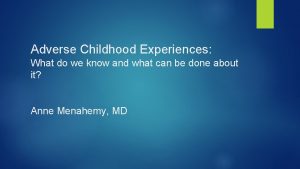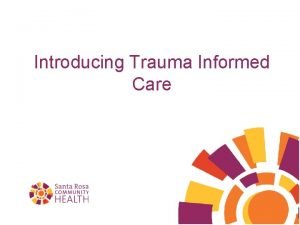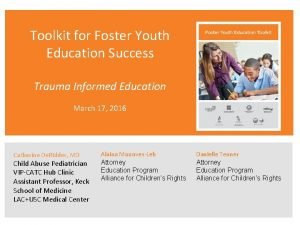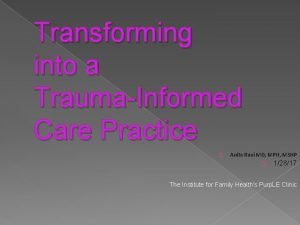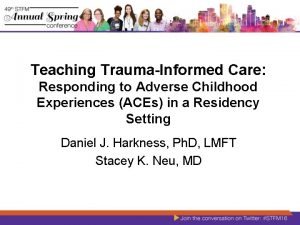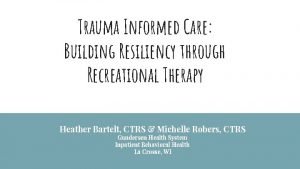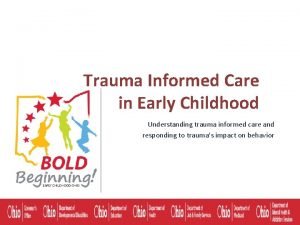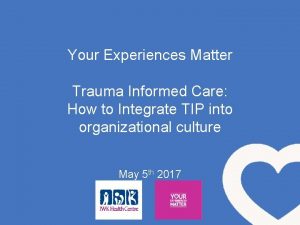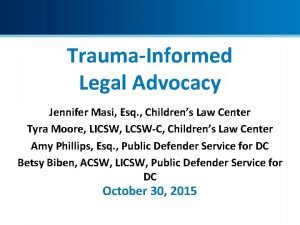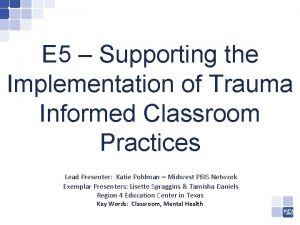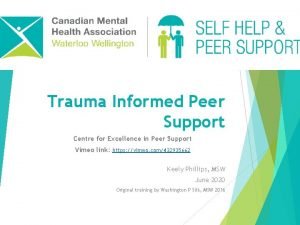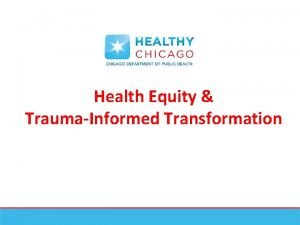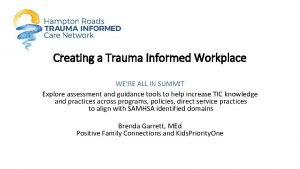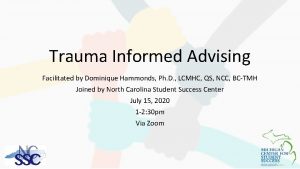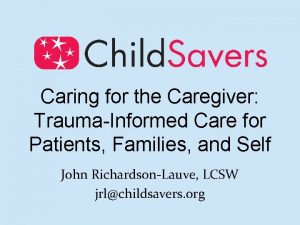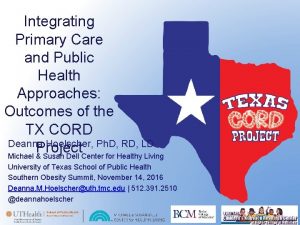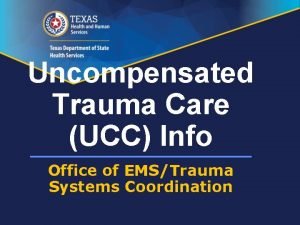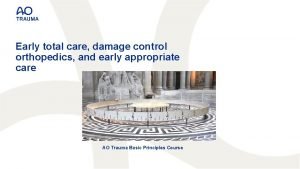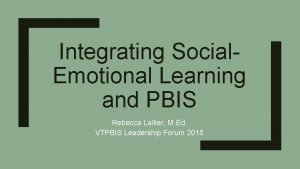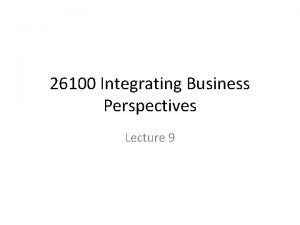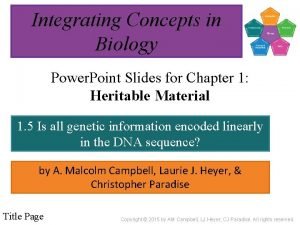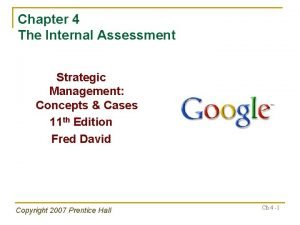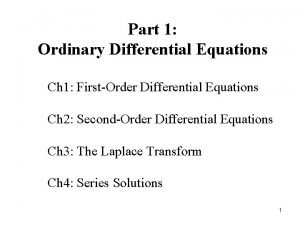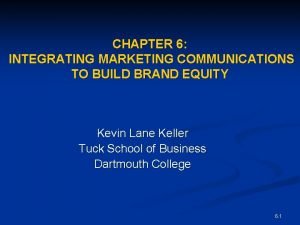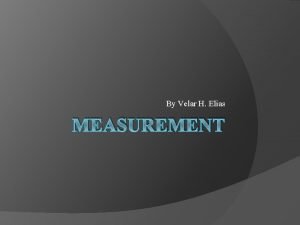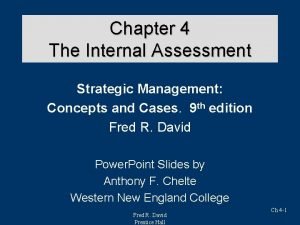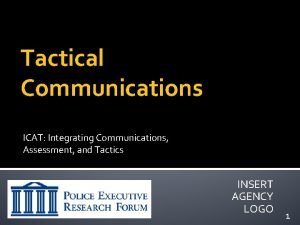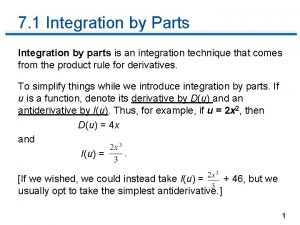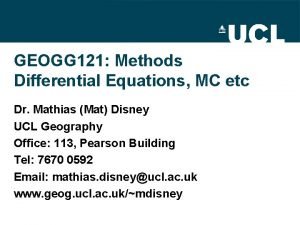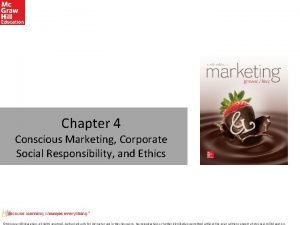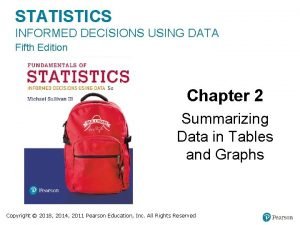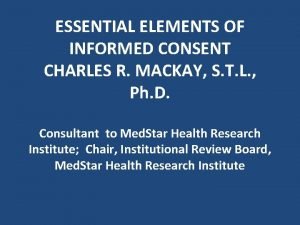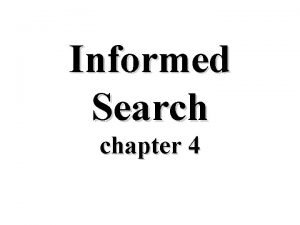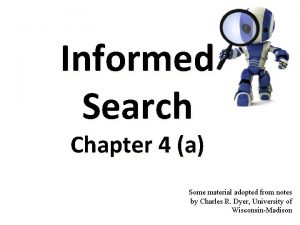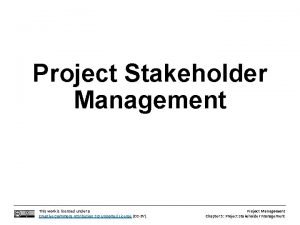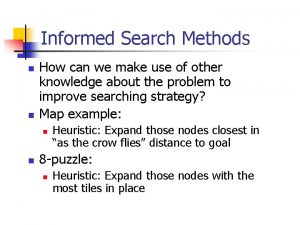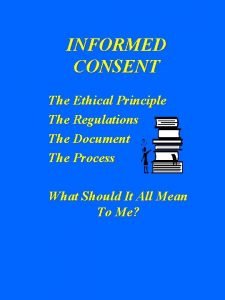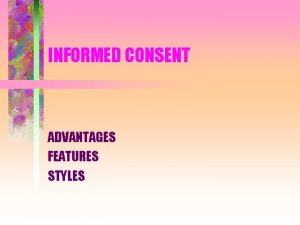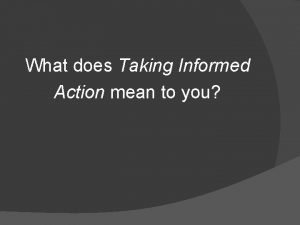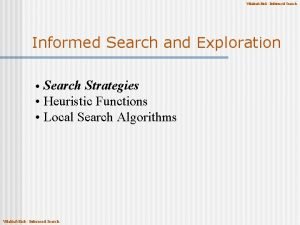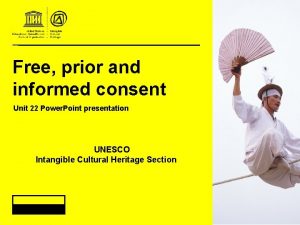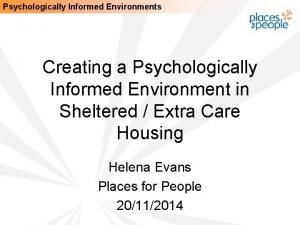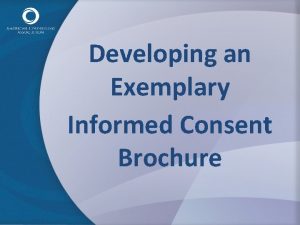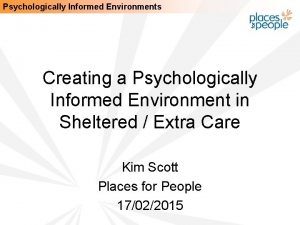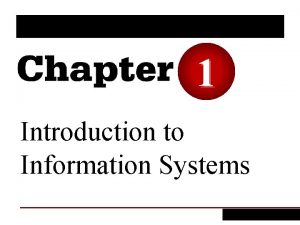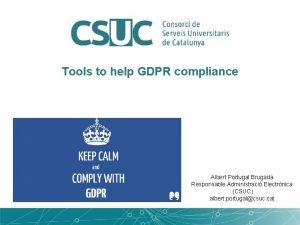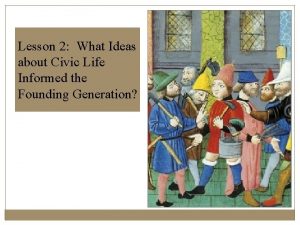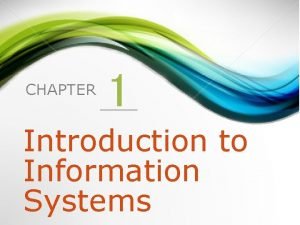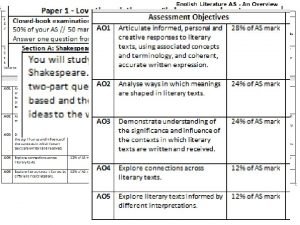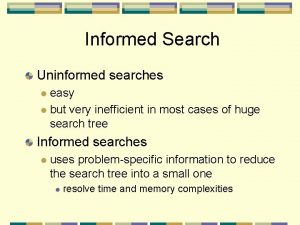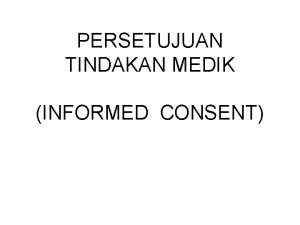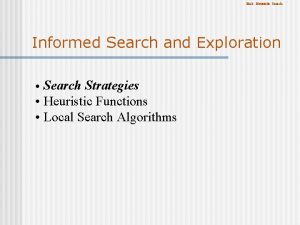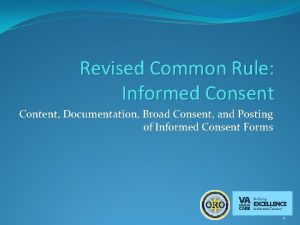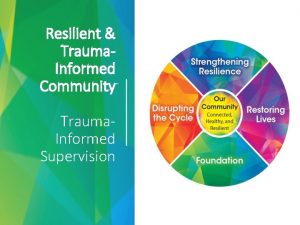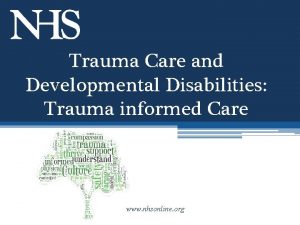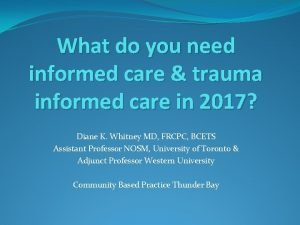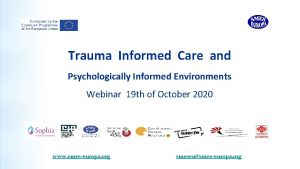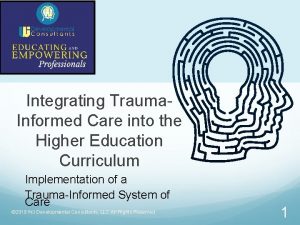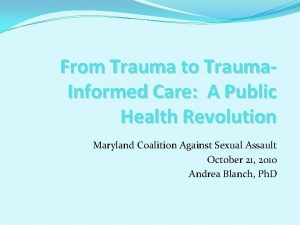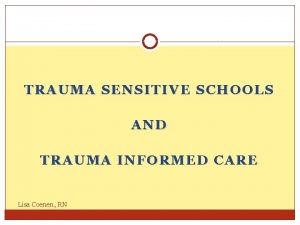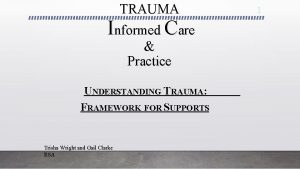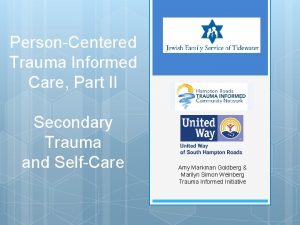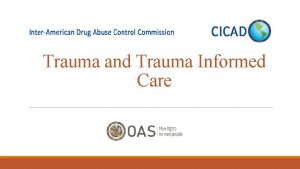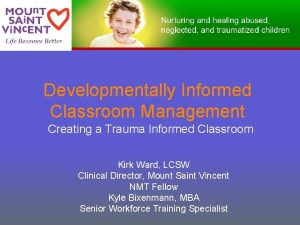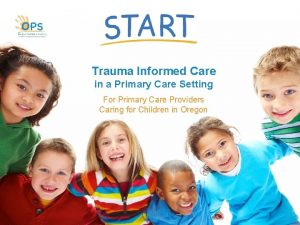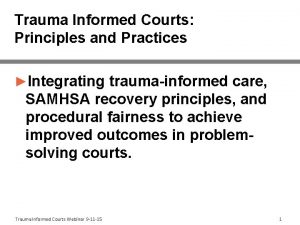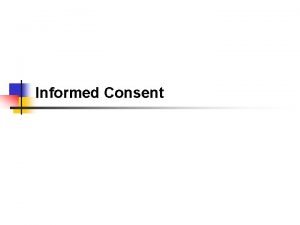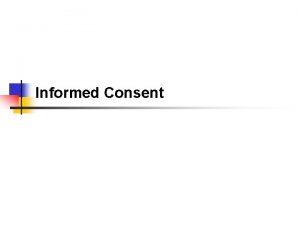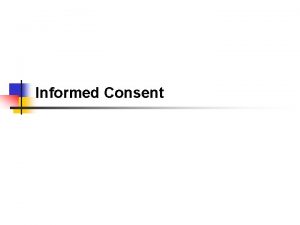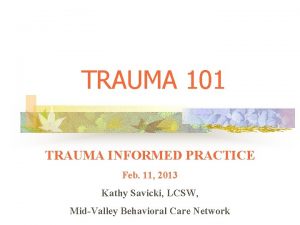Transforming Trauma Informed Care Integrating Historical Trauma in
































































































- Slides: 96

Transforming Trauma Informed Care: Integrating Historical Trauma in Behavioral Health and Primary Care Jeanne Bereiter, MD Maria Yellow Horse Brave Heart, Ph. D Division of Community Behavioral Health Department of Psychiatry and Behavioral Sciences University of New Mexico Health Sciences Center Albuquerque, NM

Disclosures • Drs. Bereiter and Brave Heart have no conflicts of interest with the material in this presentation.

Objectives • 1. Integrate five core values of Trauma Informed Care into behavioral health and primary care. • 2. Formulate examples of four Historical Trauma Response features and how they relate to complex trauma responses. • 3. Assess the consequences of trauma on physical and behavioral health. • 4. Summarize historical and cultural considerations in behavioral health treatment and primary care.

This Presentation Will Cover • Trauma informed care • Stress, ACES • Historical trauma, historical trauma response features © Maria Yellow Horse Brave Heart, Ph. D

TRAUMA INFORMED CARE

Trauma Informed Care Is… • Recovery oriented • Patient/client/consumer driven • Involves cultural humility/co-learning • Provides trauma specific services

Trauma Informed Paradigm Standard Paradigm “What happened to this person? ” “What’s strong with you? ” Historical trauma informed: “What tribal traumatic events happened over time? ” “What kind of school did you and family members attend? ” “What’s wrong with this person? ” “What’s wrong with you? ” NOT asking about collective tribal history NOT asking about boarding school history or other tribalspecific experiences and culture

Human Services Relationship Standard • Hierarchical • Trust is assumed • Safety is assumed • Patient is passive recipient of services (or chooses from a menu) Trauma-Informed • Collaborative • Trust is developed over time • Steps are taken to ensure safety • Patient is encouraged/skills developed to express choice Community Connections Trauma Informed Care (CCTIC)

What is Historical Trauma Informed Care? • Understanding the importance of cross generational and ancestral ties in tribal communities and families • Addressing cultural norms for addressing trauma and healing, traditional bereavement • Examining the collective traumatic tribal history as well as traditional cultural wisdom and resilience

5 Principles of Trauma-Informed Care (modified from CCTIC) • Safety • Trustworthiness – Making tasks clear – Maintaining appropriate boundaries • Choice – Prioritizing consumer choice and control • Collaboration – Between clinicians and consumers – Emphasizing working together on goals, not top down • Encouragement – Recognizing strengths – Skill building Creating Cultures of Trauma Informed Care (CCTIC)-Community Connections

Creating a Safe Context-Emotional Safety • Are staff, patients, and providers able to speak up? • Is the system/people in it perceived as trustworthy? – How are patients greeted at the door? – Are boundaries clear and consistent? – Transparency – Confidentiality • Including contact with relatives e. g. sensitivity to potentially unsafe situations such as domestic violence, substance use – Predictability • Is spiritual safety considered? Modified from CCTIC Creating Cultures of Trauma Informed Care (CCTIC)-Community Connections

Ways to Help Sense of Emotional Safety • Calm, slow voice • Non judgmental language • Explain need for obtaining sensitive information • Explain everything you are asking/doing before doing it • Ensure private space for interview/examination • Consider patient’s physical/emotional boundaries • Consider touch-it might be triggering

Language Has Meaning • • • English, tribal language Consumer, client, patient, relatives First name, last name Trauma survivor, cancer survivor, incest survivor Doctor, physician, clinician, therapist, counselor, provider, prescriber Empowerment, encouragement Control The way we talk to patients – Open ended versus close ended questions – “You shouldn’t, you can’t” Do we explain symptoms in a culturally appropriate/understandable way?

Trauma Informed Reminders • Trauma reactions can be triggered by sudden loud sounds, tension between people, certain smells, casual touches • Exposing one’s history can manifest in the client as feeling vulnerable and unsafe. • Sudden treatment transitions or changing provider, can evoke feelings of abandonment • Trauma survivors generally value routine and predictability. • Strive to maintain a soothing, quiet demeanor. Clients who have been traumatized may be more reactive even to benign or well-intended questions. © Maria Yellow Horse Brave Heart, Ph. D

Trustworthiness • Consider patients/relatives trust/lack of trust with IHS – Discuss ways patient/relatives might mistrust the provider • How is conflict of interest handled? • How is sensitive information protected/shared? • How are dual relationships handled? – How are boundaries protected? • Is there conflict with your agency and tribal leadership on decision making and care plans? • How is the informed consent process handled? – Appropriate to patient’s language, culture? Modified from CCTIC Creating Cultures of Trauma Informed Care (CCTIC)-Community Connections

Choice • Are patients able to choose – Their treatment provider? – Time/date of follow up appointments? – Type of treatment? – Who comes to appointments with them? – Location of services? – Emergency management? – Involvement in their care plan? Modified from CCTIC Creating Cultures of Trauma Informed Care (CCTIC)-Community Connections

Maximizing Patient Choice • Communicate clearly about: – Treatment options and choices – Limitations of services – Patient rights and responsibilities – Any contingent services and why they are contingent on participation in other services • Build in “small” choices – When and how to communicate with patient (phone, mail) – Who can attend appointments with patient/receive information about patient Modified from CCTIC Creating Cultures of Trauma Informed Care

Collaboration • How can we do with rather than do for or do to? • Is patient life experience and history respected? – Awareness of strengths and skills? – Awareness that patient/relative is the ultimate expert on their own experience • Encourage patient/relative to collaborate – Identify tasks they can work on with provider e. g. information gathering – Are treatment plans decided upon collaboratively? Modified from Creating Cultures of Trauma Informed Care (CCTIC)-Community Connections

Use of Peers • Involve peers in the organizational structure • Develop peer support services

Encouragement • Respect patient/relatives wisdom and encouraging skill building • What is patient/relatives understanding of what they need/what service are they seeking? • How are patients asked about their strengths? • How is realistic optimism communicated? • What does the program do if the patient doesn’t reach their goals? • How does the program foster the involvement of patient/relatives? Modified from Creating Cultures of Trauma Informed Care (CCTIC)-Community Connections

Staff Support and Well-Being • Support and care for entire staff • Follows the same 5 principles as used with patients: – Safety, trustworthiness, choice, collaboration, encouragement • In order to care for others we need to function well ourselves – Able to teach, role model, not be reactive, selfcontrolled, never abuse power – Minimize vicarious/secondary trauma – Remember the Ethics of Self-Care Modified from Creating Cultures of Trauma Informed Care (CCTIC)

Staff Safety • Do staff feel physically safe at work? • Do staff feel comfortable bringing their concerns to team meetings, supervision? • Is it safe for IHS staff to talk about the difficulties of working in HIS? • Does the program provide training for staff on issues of transference, counter transference, cultural formulation from a provider stance?

Staff Training • Does the program train non native staff about culture? • Do staff feel comfortable talking about culture? Blind spots? • Does the program train on the concept of internalized depression? • Does the program train on trauma, including the impact of workplace stressors? • Do staff feel spiritually safe? Is there opportunity for spiritual cleansing?

Community Partnerships • Key part of trauma informed care • Form partnerships between your agency and the community: – Police – First responders – Other medical and behavioral health organizations – Spiritual leaders, healers, churches, schools • Promotes safe communities • Decreases trauma in communities

Culture Shift • Incorporate knowledge about trauma into all aspects of services – Not just for patients we know have experienced trauma • Minimize re-victimization – Do no harm/ non maleficence – Awareness that the service system (IHS, medical, dental) has been re-traumatizing to people

Steps to Creating a Trauma Informed System • Culture shift • Involves everyone: administrators, supervisors, line staff, clinicians, patients, families • Begin with small steps • Use the same principles we use with patients Modified from Creating Cultures of Trauma Informed Care (CCTIC)

STRESS

Acute Stress • Our bodies are designed to deal with acute stress • Fight/flight/freeze reaction is initiated • This stress response system increases our ability to survive danger • Once stress is over systems return to normal (homeostasis) via negative feedback loops

Chronic Stress – Our bodies are not designed to deal with persistent stress – Same systems are activated as in acute stress, but are activated over and over – This has adverse effects: • Initial high levels of cortisol then blunted corticosteroid release • Brain changes (high levels of cortisol are toxic) – Impairs neural plasticity, damages the hippocampus which impairs memory • Epigenetic changes – leads to increased risk of physical and psychiatric illness

Epigenetics and Stress/Trauma • Gene expression is influenced by experience/environment • Stress and trauma affect gene expression • Epigenetics shows how stress/trauma can affect biological systems on a molecular level, leading to disease • Historical trauma can affect subsequent generations via epigenetics • Epigenetic changes can be reversed http: //learn. genetics. utah. edu/content/epigenetics/inheritance/

Epigenetics, Transgenerational Effects, and PTSD • Transgenerational, higher stress vulnerability (doesn’t mean poor mental health necessarily but greater risk for traumatic responses to stress and more likely to have PTSD-like symptoms) • Stressful environmental conditions can leave a genetic imprint, changes in neurobiology • Testimonies of “inherited” grief in qualitative research © Maria Yellow Horse Brave Heart, Ph. D

ADVERSE CHILDHOOD EXPERIENCES (ACES)

ACE (Adverse Childhood Experience) Study • Looked at the relationship between childhood abuse and neglect and later-life health and well-being • Original ACE study done from 1995 -1997 at Kaiser Permanente in S California in collaboration with US CDC • Surveyed 17, 000+ HMO members who completed a confidential survey given to them when they came for their physical exam – 70% Caucasian – 70% college educated


CDC. gov

Major Findings • 64% reported at least one ACE • 1 in 8 people had 4+ ACEs • Relative risk for multiple physical, mental health and psychosocial outcomes increased with number of ACEs • Risk increases even if people don’t engage in high risk behaviors such as smoking, drug or alcohol use

http: //www. npr. org/assets/imp/2015/02/ 20/aces-2_cutsom. jpg

Odds of Heart Disease With Increasing Aces http: //developingchild. harvard. edu/resources/five-numbers-to-remember-about-early-childhood-development/


ACE Scores Among AI/AN children compared with non Hispanic white children AI/AN NHW • 2+ACEs 40. 3% • 21% • 3+ ACEs 26. 8% • 11. 5% • 4+ ACEs 16. 8% • 6. 2% • 5+ ACEs 9. 9% • 3. 3% Once adjusted for sociodemographic variables, the differences between the 2 populations went away Kenney et al. , 2016


Effects of Childhood Abuse on Healthcare Behaviors • Avoidance of care – Decreased access of pap smears and mammography – Delay in seeking treatment – Decreased adherence to treatment – Avoidance can be related to fear and complex identification issues, behavioral health issues, with family members who have or died from an illness • Overutilization of care • Trauma reactions while receiving medical care Havig 2008; Weinreb 2010

Trauma-Specific Treatments – Trauma focused cognitive behavioral therapy (CBT) – Dialectical Behavioral Therapy (DBT) – Eye movement desensitization and reprocessing (EMDR) – Prolonged Exposure – Treatment for historical trauma e. g. HTUG – Psychodynamic therapy – Pharmacotherapy – Traditional healing

Trauma-Specific Treatments-continued – Body therapies “sensorimotor” • Breathing techniques • Acupuncture • Exercise • Rhythmic activities- drumming, dancing • Mindfulness meditation • Massage • Neurosequential model of therapeutics • Hakomi therapy • Equine therapy

Historical Trauma: Implications for Trauma Informed Care and Healing Tunkasila Tatanka Iyotake, Mother Holy Door, Daughter, and Grandchild

Example of Traditional Cultural Perspectives on Collective Trauma and Grief It is our way to mourn for one year when one of our relations enters the Spirit World. . . tradition is not to be happy, not to sing and dance and enjoy life’s beauty during mourning time…. to suffer with the remembering of our lost one…. And for one hundred years we as a people have mourned our great leader… blackness has been around us for a hundred years. During this time the heartbeat of our people has been weak, and our life style has deteriorated to a devastating degree. Our people now suffer from the highest rates of unemployment, poverty, alcoholism, and suicide in the country. * *From a booklet for the Sitting Bull and Bigfoot Memorial Ride; Traditional Hunkpapa Lakota Elders Council (Blackcloud, 1990) © Maria Yellow Horse Brave Heart, Ph. D

Intergenerational Parental Trauma I never bonded with any parental figures in my home. At seven years old, I could be gone for days at a time and no one would look for me…. I’ve never been to a boarding school. . all of the abuse we’ve talked about happened in my home. If it had happened by strangers, it wouldn’t have been so bad- the sexual abuse, the neglect. Then, I could blame it all on another race…. And, yes, they [my parents] went to boarding school. A Lakota Parent in Recovery (Brave Heart, 2000, pp. 254 -255) © Maria Yellow Horse Brave Heart, Ph. D

Ongoing Cumulative Losses and Trauma Exposure • Intergenerational parental trauma traced back to legacy of negative boarding school experiences • Constant trauma exposure related to deaths from alcohol -related incidents, suicides, heart disease, diabetes, cancer, etc. , and constant state of mourning • Surviving family members include individuals who are descendants of massive tribal trauma (e. g. massacres, abusive and traumatic boarding school placement) • Cumulative trauma exposure – current and lifespan trauma superimposed on collective massive • American Indians have the highest military enlistment rate than any other racial or ethnic group – extends traumatic exposure © Maria Yellow Horse Brave Heart, Ph. D

Definitions • Trauma results from event/circumstances experienced as physically or emotionally harmful or threatening with lasting adverse effects on the individual’s functioning and physical, social, emotional, or spiritual well-being* • Historical trauma - Cumulative emotional and psychological wounding from massive group trauma across generations, including lifespan • Historical trauma response (HTR) is a constellation of features in reaction to massive group trauma, includes historical unresolved grief (similar to other massively traumatized groups (Brave Heart, 1998, 1999, 2000) * (Substance Abuse and Mental Health Services Administration. Trauma-Informed Care in Behavioral Health Services. Treatment Improvement Protocol (TIP) Series 57. HHS Publication No. (SMA) 134801) © Maria Yellow Horse Brave Heart, Ph. D

Historical Trauma, Genocide and Survival: the Elephant in the Room • Congressional genocidal policy: no further recognition of their rights to the land over which they roam. …go upon said reservations…chose between this policy of the government and extermination…. wards of the government, controlled and managed at its discretion (U. S. Senate Miscellaneous Document 1868 cited in Brave Heart, 1998) • BIA started under the War Department; BIA Education Division called “Civilization Division” & IHS evolved from BIA • Congressional policy of forced separation of children from family and tribe – early boarding school trauma • Honesty about this legacy and impact upon current relationships, mistrust, and strategies to move forward are part of trauma informed care © Maria Yellow Horse Brave Heart, Ph. D

Ways HT May Be Transferred • Identification with and internalization of oppressor’s view, resulting in self-hatred, self-destructiveness • Identifying with parents’ trauma responses; other mechanisms of transfer across generations (epigenetic research may provide further insight) • Past prohibition against practice of traditional burials limited bereavement, complicating grief resolution • Active relationships with ancestor spirits and cultural attachment styles include death as a loss of part of self (e. g. exhibited by cutting the hair); without traditional culturally congruent mourning practices, grief could become impaired © Maria Yellow Horse Brave Heart, Ph. D

Prevalence and Testimonies of HT I think losing the land was the most traumatic…. I remember my… dad talked about. . . how they were treated, some were shot…They were starved. . So this happened in my great grandparents' generation when they lost the buffalo. My grandparents' generation lost the land their livelihood. . That's from generation to generation. There a lot of answers that I don't have and a lot of questions that I do have and there is a lot of hurt inside me…. Some of these things happening over the years are still happening today, like my grandparents, my great grandparents had their children moved to schools. . I was moved, my brothers and sisters moved. …There's a big hole in my heart. We see it happening to our grandchildren already. . Where does it stop? (Brave Heart, et al. , 2012) One-fifth to one-third of Indigenous adults reported thoughts pertaining to historical loss daily or several times a day, and that these thoughts have negative emotional consequences (Whitbeck et © Maria Yellow Horse Brave Heart, Ph. D al. , 2004).

Some Historical Trauma Response Features • Survivor guilt • Depression • PTSD symptoms • Psychic numbing • Fixation to trauma • Somatic (physical) symptoms • Self-destructive behavior including substance abuse • Suicidal ideation • Traditional cultural attachment • Death identity – fantasies of reunification with the deceased; cheated death • Preoccupation with trauma, with death • Loyalty to ancestral suffering & the deceased • Internalization of ancestral suffering • Vitality in own life seen as a betrayal to ancestors who suffered so much © Maria Yellow Horse Brave Heart, Ph. D

Case Example 15 year old American Indian girl with recovering boarding school survivor parents attempts suicide – after a few therapy sessions, the girl reveals that she didn’t want to burden her parents with her problems because they have suffered so much from their boarding school trauma. Video Clip: We Shall Remain by the Style. Horse Collective; Coeur d’Alene Tribal Youth Programs (see credits at end of the clip) https: //www. youtube. com/watch? v=Gs 0 iw. Y 6 Yj. Sk © Maria Yellow Horse Brave Heart, Ph. D

Setting the Stage From: http: //www. slate. com/blogs/the_vault/2014/06/17/interactive_map_loss_of_indian_land. html

Tatanka Iyotake & Sitanka Wokiksuye Sitting Bull Memorial & Bigfoot Memorial Ride 1990 – 100 years later Sitanka (Bigfoot)

Takini Wounded Knee Massacre Survivors: Tunkasila Wapaha Ska (White Lance), Joseph Horn Cloud, & Dewey Beard

Spontaneous Testimonies at the End of the Four Days of the first HTUG in 1992 • Sitanka Wokiksuye Rider – I sacrificed to wipe the tears of the people but until today, no one had wiped my tears • Expressions of transformative experience • We formed a kinship network • Own experience – further solidified my commitment to this sacred path; asked by Lakota elder to lead the people in this historical trauma healing work and have maintained this commitment • As therapists, providers, healers, we need to help to wipe our tears © Maria Yellow Horse Brave Heart, Ph. D

Historical Trauma & Unresolved Grief Intervention: Return to the Sacred Path Conf ronting Historical Understandi Trauma ng & the Trauma Embracing Our History Return to The Sacred Path Transcendin g the Trauma Releasing Our Pain

Recognize & briefly describe the value of self-knowledge and how it enters into the treatment relationship • Identify ones own HT Response Features (HTR) and tribal as well as family and individual trauma history, vulnerabilities, potential trauma triggers • This can be done through ones own HT work, therapy, and supervision with a supportive supervisor and through peer supervision, and through ceremonies • Psychoanalytic principle – one cannot take someone further in treatment than one has gone themselves – so you must go through your own healing process in order to truly be helpful to your patients/clients, work through your own resistance (which is a normal part of therapy as well as being on a spiritual path or any path of growth and development) © Maria Yellow Horse Brave Heart, Ph. D

The Wounded Healer-Chiron • A centaur in Greek mythology • Accidentally wounded, in chronic severe pain, incurable • Renowned teacher and healer

The Wounded Healer-Carl Jung • “the doctor is effective only when he himself is affected. Only the wounded physician heals. ” • Developed the “wounded healer archetype”

The Wounded Healer in AI/AN Tradition • AI/AN people are all trauma survivors – Historical trauma – Personal trauma • Many AI/N healers have had dreams and visions after surviving a physical illness • Illness was seen as part of the process for visions and receiving spiritual powers • Black Elk described in Black Elk Speaks receiving healing powers after an illness Maria Yellow Horse Brave Heart

Objective countertransference and induced countertransference • Important to attend to ones own thoughts, associations, feelings, where ones mind goes during sessions – clues to what is going on in treatment, how the patient/client might be feeling or something they may not be conscious of but that is important for the treatment • Unconscious communication – example from first microwave pizza – pay attention to where your mind may wander • Transference is the patient’s displacement or reenactment of feelings and dynamics with significant relationships, usually childhood relationships, particularly parents or caretakers. • Countertransference is the reaction of therapist to the patient’s transference.

More about objective countertransference and induced countertransference • Objective countertransference – anyone would react similarly to the patient – feelings in therapist are being induced. Feelings do not last long after the session. Staff at your clinic may also experience similar feelings towards the patient – this may be a clue. • Subjective countertransference - specific to therapist’s own reaction to patient’s behavior, communications, etc. Requires therapist’s deeper exploration in supervision and own therapy about what is getting triggered. • There could be an objective countertransference but may possibly also trigger subjective countertransference reactions based on therapist’s past relationships and issues. • Clues are thinking about patient a lot outside of sessions, more than other patients, feeling irritated or angry, etc.

Historical Trauma Response Features – may come up in countertransference reactions towards patient such as: • Survivor guilt • Depression • Sometimes PTSD symptoms • Psychic numbing • Somatic (physical) symptoms • Low self-esteem • Victim Identity • Anger • Hypervigilance • Dissociation • Compensatory fantasies • Poor affect (emotion) tolerance © Maria Yellow Horse Brave Heart, Ph. D

Some techniques to develop self-awareness and integrate it into trauma informed treatment • Journaling • Peer supervision groups • Request regular individual supervision and try using a psychodynamic supervision approach of focusing on two cases in depth – goal is to generalize learning to all cases • Advocate for supervisory safety – trauma informed – and perhaps arrange for a separate clinical supervisor from administrative supervisor • Private supervision arrangements • Advanced training programs, post-graduate institutes, peer support group, and some online therapists collectives • Literature on the wounded healer – good resources • Change the culture of your site – talk more openly about “wounded healers” and that we are all survivors of wounding • Clinical consultation groups – one starting now supported by IHS

Wakiksuyapi (Memorial People) • Takini Network/Institute as Wakiksuyapi, carrying the historical trauma but working on healing • For the Lakota, specific tiospaye (extended kinship network) or bands may carry the trauma for the Nation, i. e. those most impacted by Wounded Knee Massacre • We are descendants of traditional warriors and survivors, including 1890 Wounded Knee Massacre descendants; we are children of World War II Marine, Army, and Navy veterans; Takini includes Vietnam veterans and involving Korean War, OEF/OIF veterans • Our awareness of being Wakiksuyapi in process of healing is important for effectiveness as therapists and healers

DSM Cultural Formulation: Some Content Specific to Countertransference Cultural elements of the relationship between the individual and the clinician • Individual differences in culture & social status between the individual & clinician • Problems these differences may cause • Similarities may also be challenging – example working with a male Marine veteran and my own relationship with my deceased Marine father – and a Marine relative killed in Iraq - need for heightened awareness of countertransference issues Cultural Identity • Ethnic or cultural reference group(s) • Degree of involvement w/culture of origin & host culture • Language abilities, use, & preference • Adding tribal military culture in this consideration © Maria Yellow Horse Brave Heart, Ph. D

Culturally Sensitive Diagnosis: the DSM Cultural Formulation Overall cultural assessment for diagnosis and care • Discussion of how cultural considerations specifically influence comprehensive diagnosis and care Reference: Lewis-Fernandez, R. and Diaz, N. The Cultural Formulation: A method for assessing cultural factors affecting the clinical encounter. Psychiatric Quarterly, 2002, 73(4): 271 -295. (Table 1, p. 275) ********************************** Examples for Native clients: skin color issues, risk for trauma exposure, traditional mourning practices, racism, unemployment rates, housing availability © Maria Yellow Horse Brave Heart, Ph. D

Trauma Informed Supervision – Awareness is Key! • We bring our past into the workplace – not conscious • We often reenact our family dynamics and traumatic histories in work and personal relationships [unconscious attempt to recreate and master trauma] • We get triggered may have compassion fatigue • Supervision as a parallel process – for behavioral health providers, as we present a case we unconsciously bring in dynamics with the patient into the supervision– this is normal! Understanding this and using this in supervision help in comprehending the dynamics of a case and therapeutic relationship • Importance of self-care and attending to ones own trauma history and work those through – owe it to our patients and ourselves! Creating Cultures of Trauma Informed Care (CCTIC)

Complex Trauma • Not a DSM 5 diagnosis but planned for inclusion in ICD-11 • DSM IV field trial showed that 92% of people with complex PTSD/Complex Trauma also met diagnostic criteria for PTSD • PTSD doesn’t cover the intricacy of complex trauma nor historical trauma • Found in people who have experienced multiple, chronic or prolonged traumas • Complex trauma congruent with Historical Trauma Response but HTR includes generational prolonged and repeated trauma exposure • Symptoms may include dissociation, anger, depression, change in self concept, change in response to stressful events, irritability, frozen/restricted, flashbacks, altered perceptions/beliefs – similar to features of HTR

Complex Trauma and Historical Trauma • Complex trauma - prolonged, repeated trauma in which the person was “in a state of captivity” physically or emotionally (Herman, 1997). • Early reservation days and POW designation for some tribal groups, massacres, colonization, forced separation of children from families and tribe, may be emotionally experienced as a legacy of living in a state of captivity. • Treatment involves need for person to regain sense of control and power, and work in interpersonal relationships – many AIAN face repeated disruption in sense of agency and experiences collectively of powerlessness related to past and ongoing oppression, e. g. DAPL which has been triggering for AIAN

Vicarious or Secondary Trauma • Experienced by healthcare providers – Patients ill and dying – Hearing stories of medical trauma – Experiencing historical trauma themselves – Experiencing trauma themselves • Experienced by behavioral health providers – Hearing stories of trauma from their clients – Experiencing historical trauma themselves – Experiencing trauma themselves

Trauma informed supervision • Bringing ones past into the workplace • Getting triggered, compassion fatigue, addressing self-care • Supervision as a parallel process – when presenting a case, supervisor may start experiencing similar feelings that supervisee had in the clinical session or feelings that the patient may have had. Good to examine these – helpful to understanding the case • Importance of self-care Creating Cultures of Trauma Informed Care (CCTIC)

Trauma Informed Use of Self, Transference and Countertransference • Trauma narratives of patients will be triggering particularly if therapist has own trauma history. • Developing comfort with one’s own reactions and working on healing from one’s own trauma is essential. • Awareness of trauma is helpful rather than harmful (avoidance is worse as one can “act out” by not listening to the patient, shutting down emotionally, becoming judgmental, and interfering with the patient’s healing) • Trauma informed care includes addressing providers own needs and healing. Review information on Secondary, Vicarious Trauma, Compassion Fatigue, and Burnout

Culturally & Historically Responsive Assessment • Explore generational boarding school history, tribal traumatic events, and how these were/are processed • Explore degree of involvement in traditional Indigenous culture • Consider tribal relocations, migration, trauma in tribal community of origin, language • Attend to cultural explanation of symptoms, preferences for sources of care, including traditional healing • Role of spiritual practices & kin networks in providing support • Other issues: skin color (potential for increased risk for discrimination and race-related trauma exposure), traditional mourning practices, unemployment rates, housing availability • Individual differences in culture & social status between the individual & clinician and potential impact upon care • Utilize DSM Cultural Formulation in ALL behavioral health assessments © Maria Yellow Horse Brave Heart, Ph. D

Cultural Formulation (cont. ) specific to AIAN • Indirect styles of communication, values of noninterference and non-intrusiveness, & polite reserve may delay help-seeking and true presenting problem • Variation in eye contact; cultural differences in personal space & cross-gender interaction • Listening for the meaning in the metaphor • Client use of narratives, stories; talking in the displacement • Beginning phase may be longer © Maria Yellow Horse Brave Heart, Ph. D

The Ethics of Self-Care: Standards of self-care guidelines: • Respect for the dignity and worth of self: A violation lowers your integrity and trust. • Responsibility of self-care: Ultimately it is your responsibility to take care of yourself—and no situation or person can justify neglecting this duty. • Self-care and duty to perform: the duty to perform as a helper cannot be fulfilled if there is not, at the same time, a duty to self-care Source: Green Cross Academy of Traumatology, 2010 Challenges for AIAN providers or providers from traumatized populations – spiritual and cultural commitments to helping can present challenges for self-care – we sometimes carry the trauma of our tribal communities and ancestors

HTUG Development & the Takini Network/Institute 1980 s-2017 Tunkasila Tatanka Iyotake, Mother Holy Door, Daughter, and Grandchild

Historical Trauma and Unresolved Grief Intervention • HTUG facilitates: (1) not being alone in depression; (2) reduction of stigma through the emphasis on the collective context (3) decrease in depression; • Research team members/providers dealing with own HT and ongoing family and community trauma; • Traditional tribal culture as protective factors; • Participants’ testimonies of perceived positive response to interventions and not having had an opportunity to address HT before © Maria Yellow Horse Brave Heart, Ph. D

Historical Trauma Intervention Research & Evaluation: Qualitative Evaluation of Parental Responses • Increased sense of parental competence • Increase in use of traditional language • Increased communication with own parents and grandparents about HT • Improved relationships with children, parents, grandparents, and extended kinship network • Increased pride in being Lakota and valuing own culture, i. e. Seven Laws © Maria Yellow Horse Brave Heart, Ph. D

Websites • ACES Connection http: //www. acesconnection. com/ • ACES Too High www. acestoohigh. com • International Society for Traumatic Stress Studies (ISTSS) www. istss. org • The National Council for Behavioral Health https: //www. thenationalcouncil. org/topics/trauma-informed-care/ • National Child Traumatic Stress Network (NCTSN) http: //www. nctsn. org/

Websites-continued • PTSD: National Center for PTSD (US Department of Veterans Affairs) https: //www. ptsd. va. gov/ • SAMHSA National Center for Trauma-Informed Care and Alternatives to Seclusion and Restraint (NCTIC) https: //www. samhsa. gov/nctic • SAMHSA National Child Traumatic Stress Initiative (NCTSI) https: //www. samhsa. gov/child-trauma

References • Anda, R. F. , Felitti, V. J. , Bremner, J. D. , Walker, J. D. , Whitfield, C. , Perry, B. D. , … Giles, W. H. (2006). The enduring effects of abuse and related adverse experiences in childhood: A convergence of evidence from neurobiology and epidemiology. European Archives of Psychiatry and Clinical Neuroscience, 256(3), 174– 186. http: //doi. org/10. 1007/s 00406 -0050624 -4 • Bremness, A. , & Polzin, W. (2014). Commentary: Developmental Trauma Disorder: A Missed Opportunity in DSM V. Journal of the Canadian Academy of Child and Adolescent Psychiatry, 23(2), 142– 145. • Brockie, T. N. , Heinzelmann, M. , & Gill, J. (2013). A Framework to Examine the Role of Epigenetics in Health Disparities among Native Americans. Nursing Research and Practice, 2013, 410395. http: //doi. org/10. 1155/2013/410395

References-2 • Felitti, V. , Anda, R. , Nordenberg D. , Williamson, M, Spitz, A. , Edwards, V. , Koss, M. , Marks, J. Relationship of childhood abuse and household dysfunction to many of the leading causes of death in adults: The Adverse Childhood Experiences (ACE) Study. American Journal of Preventive Medicine, 1998, 14: 245 -258 • Figley, C. R. (ed. ) (1995) Compassion Fatigue: Secondary Traumatic Stress Disorders from Treating the Traumatized, NY Brunner-Mazel • Kirsten Havig (2008) The Health care Experience of Adult Survivors of Child Sexual Abuse, Trauma, Violence, and Abuse Vol 9, Issue 1, pp 19 -33

References 3 • (Herman, J. (1997). Trauma and recovery: The aftermath of violence from domestic abuse to political terror. New York: Basic Books. ) • Mary Kay Kenney and Gopal K. Singh, “Adverse Childhood Experiences among American Indian/Alaska Native Children: The 2011 -2012 National Survey of Children’s Health, ” Scientifica, vol. 2016, Article ID 7424239, 14 pages, 2016. doi: 10. 1155/2016/7424239 • Natalie J. Sachs-Ericsson, Nicole C. Rushing, Ian H. Stanley, and Julia Sheffler In my end is my beginning: developmental trajectories of adverse childhood experiences to late-life suicide, Aging & Mental Health Vol. 20 , Iss. 2, 2016 • Pechtel, P. , & Pizzagalli, D. A. (2011). Effects of Early Life Stress on Cognitive and Affective Function: An Integrated Review of Human Literature. Psychopharmacology, 214(1), 55– 70. http: //doi. org/10. 1007/s 00213 -0102009 -2

References-4 • Yehuda & Bierer, (2009) J of Traumatic Stress, 22 (5) • Yehuda, et al. , (2005) J of Clinical Endocrinology & Metabolism, 90 (7) • Walters et al. , (2011) Du Bois Review: Social Science Research on Race, 8(1)

Relevant Recent HT Publications • Brave Heart, M. Y. H. , Elkins, J. , Tafoya, G. , Bird, D. , & Salvador (2012). Wicasa Was'aka: Restoring the traditional strength of American Indian males. American Journal of Public Health, 102 (S 2), 177 -183. • Brave Heart, M. Y. H. , Chase, J. , Elkins, J. , & Altschul, D. B. (2011). Historical trauma among Indigenous Peoples of the Americas: Concepts, research, and clinical considerations. Journal of Psychoactive Drugs, 43 (4), 282 -290. • Brave Heart, M. Y. H. & Deschenie, T. (2006). Resource guide: Historical trauma and post-colonial stress in American Indian populations. Tribal College Journal of American Indian Higher Education, 17 (3), 24 -27. • Brave Heart, M. Y. H. (2003). The historical trauma response among Natives and its relationship with substance abuse: A Lakota illustration. Journal of Psychoactive Drugs, 35(1), 7 -13. Maria Yellow Horse Brave Heart, Ph. D

Relevant Recent HT Publications • Brave Heart, M. Y. H. , Elkins, J. , Tafoya, G. , Bird, D. , & Salvador (2012). Wicasa Was'aka: Restoring the traditional strength of American Indian males. American Journal of Public Health, 102 (S 2), 177 -183. • Brave Heart, M. Y. H. , Chase, J. , Elkins, J. , & Altschul, D. B. (2011). Historical trauma among Indigenous Peoples of the Americas: Concepts, research, and clinical considerations. Journal of Psychoactive Drugs, 43 (4), 282 -290. • Brave Heart, M. Y. H. (2003). The historical trauma response among Natives and its relationship with substance abuse: A Lakota illustration. Journal of Psychoactive Drugs, 35(1), 7 -13. • Evans-Campbell T, Lindhorst T, Huang B, Walters KL (2006) Interpersonal violence in the lives of urban American Indian and Alaska Native women: implications for health, mental health, and help-seeking. Am J Public Health 96(8): 1416– 1422. doi: 10. 2105/ AJPH. 2004. 054213 Maria Yellow Horse Brave Heart, Ph. D

References-Brave Heart • Brave Heart, M. Y. H. , Lewis-Fernández, R, Beals, J, Hasin, D, Sugaya, L, Wang, S, Grant, BF. , Blanco, C. (2016). Psychiatric Disorders and Mental Health Treatment in American Indians and Alaska Natives: Results of the National Epidemiologic Survey on Alcohol and Related Conditions. Social Psychiatry and Psychiatric Epidemiology, 51 (7), 1033 -1046. • Brave Heart, M. Y. H. , Chase, J. , Elkins, J. , Nanez, J. , Martin, J. , & Mootz, J. (2016). Women finding the way: American Indian women leading intervention research in Native communities. American Indian and Alaska Native Mental Health Research Journal 23 (3), 24 -47. • Brave Heart, M. Y. H. , Bird, D. M. , Altschul, D. , & Crisanti, A. (2014). Wiping the tears of American Indian and Alaska Native youth: Suicide risk and prevention. In J. I. Ross (Ed. ), Handbook: American Indians at Risk (pp. 495515). Santa Barbara, CA: ABC- CLIO Greenwood.

References-Brave Heart-continued • • Brave Heart, M. Y. H. (1999) Oyate Ptayela: Rebuilding the Lakota Nation through addressing historical trauma among Lakota parents. Journal of Human Behavior and the Social Environment, 2(1/2), 109 -126. Brave Heart, M. Y. H. (2000) Wakiksuyapi: Carrying the historical trauma of the Lakota. Tulane Studies in Social Welfare, 21 -22, 245 -266. Brave Heart, M. Y. H. (2001) Clinical assessment with American Indians. In R. Fong & S. Furuto (Eds), Cultural competent social work practice: Practice skills, interventions, and evaluation (pp. 163 -177). Reading, MA: Longman Publishers. Brave Heart, M. Y. H. (2001) Clinical interventions with American Indians. In R. Fong & S. Furuto (Eds). Cultural competent social work practice: Practice skills, interventions, and evaluation (pp. 285 -298). Reading, MA: Longman Publishers. © Maria Yellow Horse Brave Heart, Ph. D

References-Brave Heart continued • • Beals, J. , Manson, S. , Whitesell, N. Spicer, P. , Novins, D. & Mitchell, C. (2005). Prevalence of DSM-IV disorders and attendant help-seeking in 2 American Indian reservation populations. Archives of General Psychiatry, 162, 99 -108. Beals J, Belcourt-Ditloff A, Garroutte EM, Croy C, Jervis LL, Whitesell NR, Mitchell CM, Manson SM, Team AI-SUPERPFP (2013) Trauma and conditional risk of posttraumatic stress dis- order in two American Indian reservation communities. Soc Psych Epid 48(6): 895– 905. doi: 10. 1007/s 00127 -012 -0615 - 5 Beals J, Manson SM, Croy C, Klein SA, Whitesell NR, Mitchell CM, AISUPERPFP Team (2013) Lifetime prevalence of post- traumatic stress disorder in two American Indian reservation populations. J Trauma Stress 26(4): 512– 520. doi: 10. 1002/jts. 21835 Brave Heart MYH (1998) The return to the sacred path: healing the historical trauma response among the Lakota. Smith Coll Stud Soc 68(3): 287– 305. doi: 10. 1080/00377319809517532 © Maria Yellow Horse Brave Heart, Ph. D

References-Brave Heart continued • • Legters, L. H. (1988). The American genocide. Policy Studies Journal, 16 (4), 768 -777. Lewis-Fernandez, R. & Diaz, N. (2002). The cultural formulation: A method for assessing cultural factors affecting the clinical encounter. Psychiatric Quarterly, 73(4), 271 -295. Manson, S. , Beals, J. , O’Nell, T. , Piasecki, J. , Bechtold, D. , Keane, E. , & Jones, M. (1996). Wounded spirits, ailing hearts: PTSD and related disorders among American Indians. In A. Marsella, M. Friedman, E. Gerrity, & R. Scurfield (Eds), Ethnocultural aspects of Posttraumatic Stress Disorder (pp. 255 -283). Washington DC: American Psychological Association. Robin, R. W. , Chester, B. , & Goldman, D. (1996). Cumulative trauma and PTSD in American Indian communities (pp. 239 -253). In Marsella, A. J. , Friedman, M. J. , Gerrity, E. T. , & Scurfield, R. M. (Eds), Ethnocultural aspects of Post-traumatic Stress Disorder. Washington, DC: American Psychological Press © Maria Yellow Horse Brave Heart, Ph. D

References-Brave Heart continued • Robin, R. , Chester, B. , Rasmussen, J. , Jaranson, J. & Goldman, D. (1997). Prevalence and characteristics of trauma and posttraumatic stress disorder in a southwestern American Indian community. American Journal of Psychiatry, 154(11), 1582– 1588. • Shear, K. , Frank, E. , Houck, P. R. , and Reynolds, C. F. Treatment of complicated grief: A randomized controlled trial, 2005, JAMA, 293 (21), 2601 -2608. • US Senate Miscellaneous Document, #1, 40 th Congress, 2 nd Session, 1868, [1319] © Maria Yellow Horse Brave Heart, Ph. D

References-Brave Heart continued • • • Brave Heart, M. Y. H. (1999) Gender differences in the historical trauma response among the Lakota. Journal of Health and Social Policy, 10(4), 1 -21. Brave Heart, M. Y. H. (1999). “Oyate Ptayela: Rebuilding the Lakota nation through addressing historical trauma among Lakota parents. ” Journal of Human Behavior in the Social Environment, 2(1 -2), 109 -126. Whitbeck LB, Adams GW, Hoyt DR, & Chen X, (2004). Conceptualizing and measuring historical trauma among American Indian people. American Journal of Community Psychology, 33( 3 -4): 119 -30. Brave Heart MYH, De. Bruyn LM (1998) The American Indian holocaust: healing historical unresolved grief. Am Indian Alaska Nat 8(2): 56– 78. doi: 10. 5820/aian. 0802. 1998. 60 Beals J, Manson SM, Croy C, Klein SA, Whitesell NR, Mitchell CM, AI-SUPERPFP Team (2013) Lifetime prevalence of post- traumatic stress disorder in two American Indian reservation populations. J Trauma Stress 26(4): 512– 520. doi: 10. 1002/jts. 21835 © Maria Yellow Horse Brave Heart, Ph. D
 4 r's trauma informed care
4 r's trauma informed care Trauma informed icebreakers
Trauma informed icebreakers Lgbtq trauma informed care
Lgbtq trauma informed care Libby bergman
Libby bergman Trauma informed care for foster youth
Trauma informed care for foster youth Dr anita ravi
Dr anita ravi Tina champagne sensory modulation and environment
Tina champagne sensory modulation and environment Trauma-informed care cheat sheet
Trauma-informed care cheat sheet Trauma-informed care cheat sheet
Trauma-informed care cheat sheet 4 r's trauma informed care
4 r's trauma informed care Trauma informed practice
Trauma informed practice Jennifer masi
Jennifer masi Trauma informed physical environment
Trauma informed physical environment Kobtion
Kobtion Trauma informed practice
Trauma informed practice Trauma-informed workplace checklist
Trauma-informed workplace checklist Acessexual
Acessexual Trauma informed advising
Trauma informed advising Trauma-informed questions for clients
Trauma-informed questions for clients Integrating public health and primary care
Integrating public health and primary care Primary, secondary, tertiary care
Primary, secondary, tertiary care Dshs uncompensated trauma care application
Dshs uncompensated trauma care application Early total care
Early total care How to lead into a quote
How to lead into a quote Integrating sel and pbis
Integrating sel and pbis Integrating business perspectives
Integrating business perspectives Integrating concepts in biology
Integrating concepts in biology Knapp's stages of coming together
Knapp's stages of coming together Solution to it
Solution to it Integrating classification and association rule mining
Integrating classification and association rule mining Integrating factor
Integrating factor What is a first order equation
What is a first order equation Integrating factor non exact equations
Integrating factor non exact equations Integrating quotes mla
Integrating quotes mla Chapter 4 strategic management
Chapter 4 strategic management Integrating factor
Integrating factor Integrating marketing communication to build brand equity
Integrating marketing communication to build brand equity Plm microsoft integration
Plm microsoft integration Integrating qualitative and quantitative methods
Integrating qualitative and quantitative methods Paragraph
Paragraph Process indicators enable a software project manager to
Process indicators enable a software project manager to Integrating type dvm
Integrating type dvm Sensory
Sensory Separation of variables
Separation of variables Integrate quotes
Integrate quotes A firm's strengths that cannot be easily matched
A firm's strengths that cannot be easily matched Basic concepts on integrating technology in instruction
Basic concepts on integrating technology in instruction Tactical communication skills
Tactical communication skills Integrating science and social studies
Integrating science and social studies Integrating quotations exercise
Integrating quotations exercise Integration by parts tabular method
Integration by parts tabular method Differential equation exponential solution
Differential equation exponential solution Integration composite function
Integration composite function Seperation of variables
Seperation of variables Understanding how csr differs from conscious marketing
Understanding how csr differs from conscious marketing Informed delivery campaigns
Informed delivery campaigns Statistics informed decisions using data 5th edition pdf
Statistics informed decisions using data 5th edition pdf Essential elements of informed consent
Essential elements of informed consent Advantages of informed search
Advantages of informed search Informed search example
Informed search example An informed guess or assumption about a certain problem
An informed guess or assumption about a certain problem Stakeholder mapping
Stakeholder mapping Greedy search
Greedy search Ethical principles governing informed consent process
Ethical principles governing informed consent process Advantages of informed consent
Advantages of informed consent Psychologically informed environments
Psychologically informed environments What is informed action
What is informed action Informed search
Informed search Best first search
Best first search 22power dot com
22power dot com Psychologically informed environment
Psychologically informed environment Informed search and uninformed search
Informed search and uninformed search Comparison of uninformed search strategies
Comparison of uninformed search strategies Informed consent brochure
Informed consent brochure Psychologically informed environments
Psychologically informed environments Is a consultative function of the mis department
Is a consultative function of the mis department Stakeholder mapping exercise
Stakeholder mapping exercise Right to be informed
Right to be informed Usps informed consent
Usps informed consent What philosophical ideas informed the founding generation?
What philosophical ideas informed the founding generation? Informed user of information systems
Informed user of information systems Informed personal response
Informed personal response Uninformed and informed search
Uninformed and informed search Undang undang persetujuan tindakan kedokteran
Undang undang persetujuan tindakan kedokteran Informed decision making skills
Informed decision making skills Informed (heuristic) search strategies
Informed (heuristic) search strategies Solace american pie
Solace american pie Broad informed consent
Broad informed consent Informed delivery for business mailers
Informed delivery for business mailers Palliative care vs hospice care
Palliative care vs hospice care Hip fracture care clinical care standard
Hip fracture care clinical care standard Care certificate standard 3
Care certificate standard 3 Cum se înmulțesc mamiferele
Cum se înmulțesc mamiferele Health and social care unit 2
Health and social care unit 2 Care sunt simturile prin care sunt evocate
Care sunt simturile prin care sunt evocate Magneții atrag corpuri care conțin
Magneții atrag corpuri care conțin Care certificate standard 3 duty of care answers
Care certificate standard 3 duty of care answers
